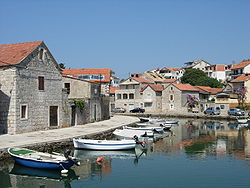History
Founded in the Middle Ages, the oldest building is the church of St Peter, which was built before the 14th century between the boundaries of Pitve and Vrbanj. In the immediate vicinity, on the Stari Grad Plain, is the ancient Villa Rustica.
Matija Ivanić, the populist leader of the Hvar Rebellion of 1510-1514, had a house in Vrboska. The Venetian troops attacked the town in 1510, causing extensive damage. In 1571, the town was again attacked, this time by the Turks, under Uluz Ali. Soon afterwards, in 1575, the church of St Mary was fortified, to become a church-fortress, the only such structure in the archipelago.
The place developed as a fishing community, trading and growing in prosperity. At the beginning of the 20th century, Vrboska had a sardine factory, wooden boat-building industry, a hotel, fishing trade association, and regular boat connections with Split and the neighbouring island of Brač. There was a community hall, library and health clinic.
Culture
The church of St. Mary of Mercy was re-built in the shape of a fortress around 1575 following the Turkish attack on the older church from 1465. The parish church of St. Lovrinac was built in 1571, and restored in the 17th century. The main altar of St. Lovrinac has a Paola Veronesca, and work of John Rendic. There are also paintings by the Venetian Masters: Tizian, Cagaliarija, Bassano, Scuria, Cellinia and others. The church of St. Peter, mentioned in 1331, was a border point between the territory of neighbouring villages Pitve and Vrbanj, even before the founding of Vrboska. Restored in 1469 it is considered one of the oldest religious buildings on the island.
The patron saint of Vrboska is St Lovrinac.
This page is based on this
Wikipedia article Text is available under the
CC BY-SA 4.0 license; additional terms may apply.
Images, videos and audio are available under their respective licenses.







